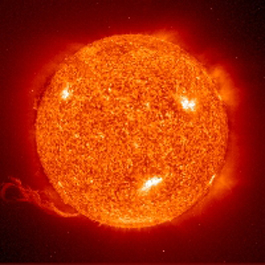Nuclear energy is energy in the core of an atom
Atoms are tiny particles in the molecules that make up gases, liquids, and solids. Atoms are made up of three particles, called protons, neutrons, and electrons. An atom has a nucleus (or core) containing protons and neutrons, which is surrounded by electrons. Protons carry a positive electrical charge, and electrons carry a negative electrical charge. Neutrons do not have an electrical charge. Enormous energy is present in the bonds that hold the nucleus together. This nuclear energy can be released when those bonds are broken. The bonds can be broken through nuclear fission, and this energy can be used to produce (generate) electricity.
In nuclear fission, atoms are split apart, which releases energy. All nuclear power plants use nuclear fission, and most nuclear power plants use uranium atoms. During nuclear fission, a neutron collides with a uranium atom and splits it, releasing a large amount of energy in the form of heat and radiation. More neutrons are also released when a uranium atom splits. These neutrons continue to collide with other uranium atoms, and the process repeats itself over and over again. This process is called a nuclear chain reaction. This reaction is controlled in nuclear power plant reactors to produce the desired amount of heat.
Nuclear energy can also be released in nuclear fusion, where atoms are combined or fused together to form a larger atom. Fusion is the source of energy in the sun and stars. Developing technology to harness nuclear fusion as a source of energy for heat and electricity generation is the subject of ongoing research, but whether it will be a commercially viable technology is not yet clear because of the difficulty in controlling a fusion reaction.
Nuclear fuel—uranium
Uranium is the fuel most widely used by nuclear plants for nuclear fission. Uranium is considered a nonrenewable energy source, even though it is a common metal found in rocks worldwide. Nuclear power plants use a certain kind of uranium, referred to as U-235, for fuel because its atoms are easily split apart. Although uranium is about 100 times more common than silver, U-235 is relatively rare.
Most U.S. uranium ore is mined in the western United States. Once uranium is mined, the U-235 must be extracted and processed before it can be used as a fuel.
Last updated: August 21, 2023.


